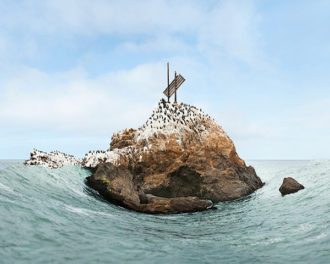
Portrait of Cultivation from Rasen Kaigan (Spiral Shore) 2009, Shiga Lieko. Chromogenic print, 47 1/4 × 70 7/8 in. The J. Paul Getty Museum, Purchased with funds provided by the Photographs Council, 2015.1.4. © Shiga Lieko
Since its advent, photography has played a key role in individual and cultural memory—a role especially evident after traumatic events. Shiga Lieko, one of five photographers featured in the exhibition The Younger Generation: Contemporary Japanese Photography, experienced this intimately when natural disaster struck her community.
In 2008 the artist had moved to Kitakama, a coastal village in the Tōhoku region of northern Japan. She became the resident town photographer, documenting the events, culture, and spirit of the place while slowly building relationships and earning the trust of the community. Such work with local communities—integrating their landscape, history, and myths into her images—is integral to her practice.
Shiga worked on a series of haunting photographs titled Rasen Kaigan (Spiral Shore), six of which are included in the exhibition. She made the photographs “as though her photography were inseparable from her own body—as if inhaling Kitakama’s air as deeply as possible and then slowly, quietly breathing it out.”

Rasen Kaigan 21 from Rasen Kaigan (Spiral Shore), 2012, Shiga Lieko. Chromogenic print, 23 5/8 × 35 7/16 in. The J. Paul Getty Museum, Purchased with funds provided by the Photographs Council, 2015.1.2. © Shiga Lieko
Private Images Washed Ashore
On March 11, 2011, everything changed: A magnitude 9.0 earthquake struck off the Tōhoku coast, triggering a tsunami that devastated the region and caused a nuclear meltdown at the Fukushima Daiichi Nuclear Power Plant. In Kitakama—population 370—over 50 people were killed. Infrastructure, including Shiga’s home and studio, were swept away.
Shiga’s role as the town photographer changed, too. She threw herself into preserving the past, even as others began documenting the present. The disaster littered the area with photographs swept from homes. Shiga and others collected the photographs, which were then transported to the community center. Becoming involved with this project was a natural step for Shiga, whose work had long been concerned with oral history and the stories of the people from Miyagi prefecture.
In an essay related to her 250-photograph series Rasen Kaigen (Spiral Shore), Shiga wrote about the impact of the tsunami and recovery efforts:
At first I thought these personal photographs should remain untouched by others. But covered with mud, they were beginning to get moldy, and those that had been in water for a long time were starting to disintegrate. They had to have the salt rinsed off and be dried. If left as they were, they would be destroyed before their owners came back for them. The trouble that had gone into collecting them and bringing them here would have been wasted. Deciding that since they were photographs, cleaning them up was part of my job as neighborhood photographer, I set to the task.
As I was cleaning the photographs, I inevitably and literally “touched” the images in them. When I wiped off the surface dirt and slime, when I hung them up to dry, when I placed the dried photo in a clear plastic box, at each of those stages I saw and touched the images in the photos. I was allowed, in this limited instance, to touch things that I had thought I should not touch.

Rasen Kaigan 39 from Rasen Kaigan (Spiral Shore), 2009, Shiga Lieko. Chromogenic print, 23 5/8 × 35 7/16 in. The J. Paul Getty Museum, Purchased with funds provided by the Photographs Council, 2015.1.3. © Shiga Lieko
Remembering 3.11
Given the prevalence of digital cameras and camera phones, almost anyone could—and did—record photographs or videos of the disaster and its aftermath. These images, along with videos, sound recordings, and writings, form the basis of the center for remembering 3.11 (commonly known as recorder311) at the Sendai Mediatheque. The center’s mission is to preserve these recollections and make them publicly available for current and future generations.
Recorder311’s archive features different types of disaster-related photographs. There are images of scenes from before the tsunami, areas that were formerly considered “nothing of importance.” Fixed-point observation photographs document how specific locations did or did not change. There are also first-hand documents of individuals’ experiences of March 11 and the recovery efforts. Such images capture not only the altered landscape, but also the changes to daily life for those affected by the disaster, such as the lengthy lines at grocery stores.
Photographs seemed to take on an ineffable power in the aftermath of the tsunami. In her essay, Shiga recollects the story of a woman who lost her house and daughter. She kept returning to the community center, asking whether any photographs of her daughter had turned up. “I realized that it wasn’t actually a photograph she was looking for, it was her daughter,” Shiga wrote. “The idea of ‘a photo of my daughter’ had been transformed into a dimension beyond the mere photograph.”
No Past, Present, Future
Shiga’s series Rasen Kaigan was first exhibited a year after the earthquake at the Sendai Mediatheque, host of the recorder311 project. The images possess a dreamlike, postapocalyptic quality that evokes myth, natural disaster, and trauma.
As the artist describes on her website:
The title “Rasen-Kaigan” means “Rasen = spiral / helical-morphology, Kaigan=coast” in direct translation but I also meant “Past, Present, Future” with this title. In the space of photographs, there is no past, present or future: the value of the photographs swings from being treated as a paper garbage to a same value of the living human being, or more, a subject for a prayer.





Comments on this post are now closed.